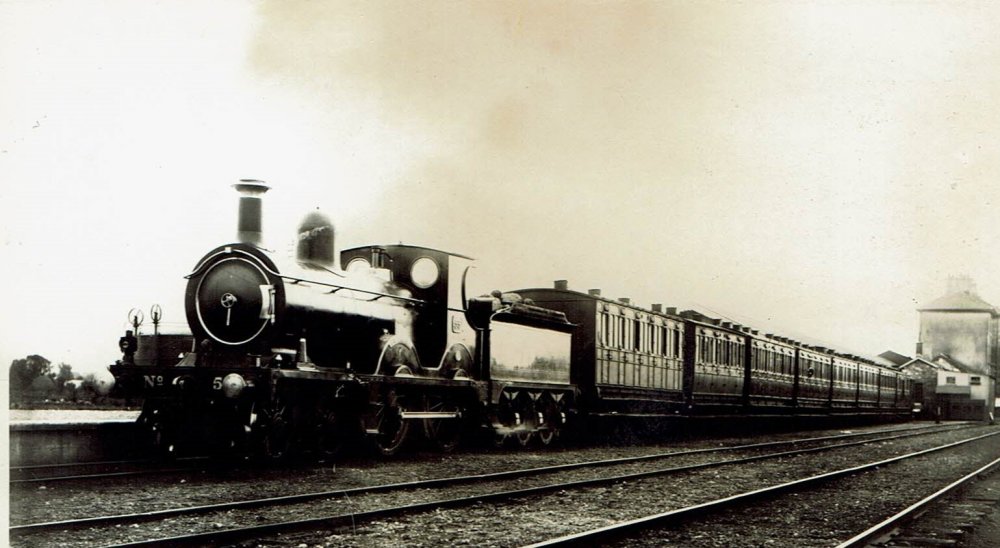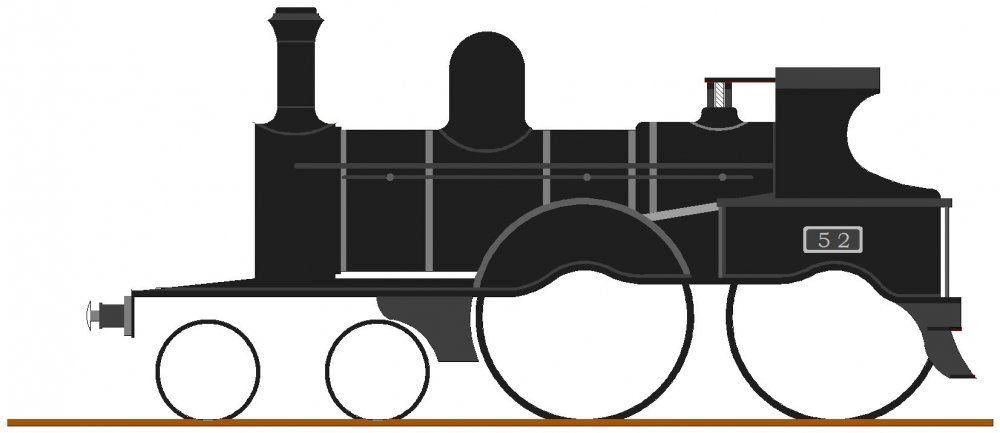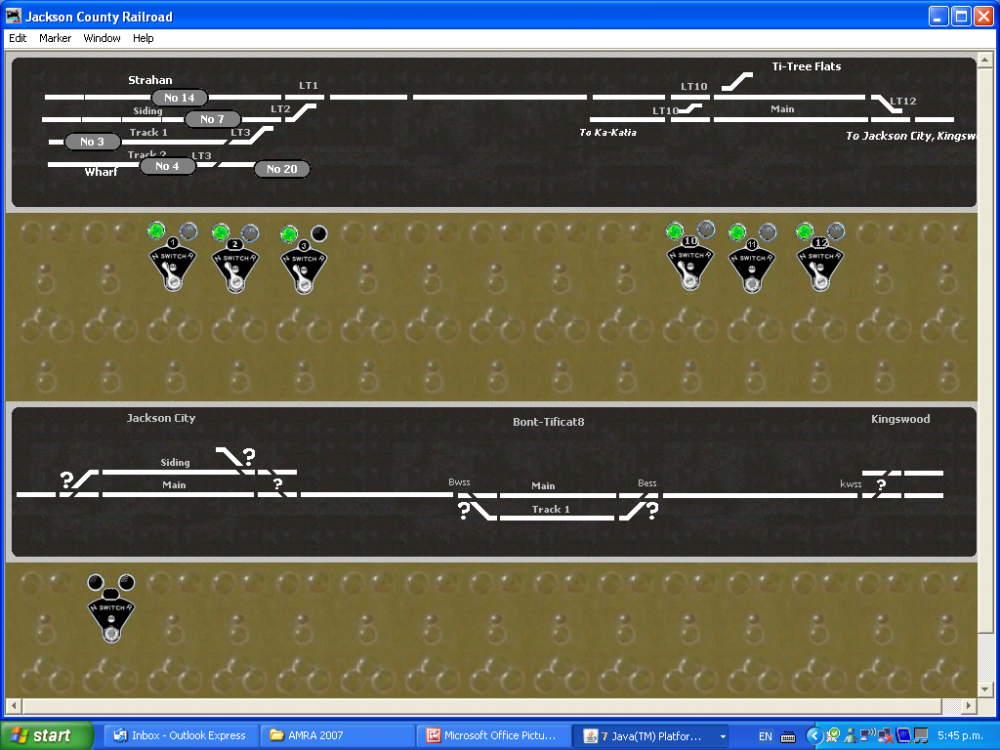-
Posts
4,855 -
Joined
-
Last visited
-
Days Won
119
Content Type
Profiles
Forums
Events
Gallery
Blogs
Store
Community Map
Everything posted by Mayner
-

Narrow Gauge in the Rockies not quite
Mayner replied to Mayner's topic in US / Canadian Railway Modelling
After a long hot Summer it looks like Autumn has arrived with leaves falling, (probably more from drought than shorter days) the end of daylight saving is two weeks away and the beginning of this years Autumn stock rush on the Jackson County Narrow gauge with every loco in steam and stock car out on the line. 463 hauls in the empties on the 1st special of the season with an empty boxcar and a laden tank car to make up a full load for the K27. A cut of cars for the Arboles Turn is stage in the yard in the background. 463 pulls into the yard while 348 waits to work the Arboles Turn and 464 waits on shed to work a Westbound freight. The turntable is a piece of decking timber pivoted on a coach screw and plate washer packers and really-really works. I re-ballasted the main line and through tracks in this area over the Christmas. 348 takes water before leaving on the Arboles Turn a locoal working. The DRGW used small 2-8-0s on branch lines and lines with restricted axle loading concentrating its narrow gauge 2-8-2s on steeply graded lines with heavy traffic. 348 arrives at Arboles before switching the yard. I am hoping to tidy up the area on the right with better screening between the outdoor work area and railway. Town is named after some trees planted 2-3 years ago. Upon arriving 348 set back with her train dropping the caboose on the other side of the bridge so the conductor could get some sleep/do the paperwork while the rest of the crew (2 brakemen, engineer & stoker) switched the train. The loco ran round the train via the siding to place the tank car on a dead end spur. I used JMRI Panel-Pro Operations Programme as a car sorting and dispatching programme. 348s cars came in on an earlier train behind 464 which included cars for Jackson City, Arboles and Utah Junction. 348 has completed her switching at Arboles , picked up her caboose and is ready to depart for her destination with a flat car, train manifest on the benchwork in the background.. The DRGW used box cars for metal ore trains on the narrow gauge (including gold-silver-zinc and radio active ores) so they can be used to serve many industries. 348 has dropped off he load and ready to depart her destination with her caboose, perhaps returning in a few days to collect her traffic. Departure time at Jackson City 463 wait waits with the 1st laden stock special of the season, 464 waits with a manifest freight. 463 bites the dust having split the points at Utah Junction not an uncommon occurrence on the full size Rio Grande Southern. Playing trains live steam Accucraft C16 passing Jackson City -
That was quick. I posted your kits on Saturday. The Mashima 10X20 motors is probably the best option for a small 2-4-0 or 0-6-0. I prefer the High Level "Road Runner +" & "Load Hauler +" gearboxes driving on the rear axle leaving the cab interior free. I used a Branchlines "Slimline" box in a J15 but it may encroach more into the cab Vertical motor in firebox High Level Road Runner + gearbox (excess motor shaft requires cutting off) 10X20 Mashima motor with flywheel horizontal in boiler firebox High Level Road Runner + gearbox
-
The lighting system depended on the railway. The MGWR seems to have used oil lighting on 6w stock with top hat lamps, some coaches appear to have had ventilators others not. Attock 4 compt Lav 2nd 1908 4 Compt 3rd with brake Compt. WLWR had introduced electric carriage lighting before the GSWR takeover but may have been restricted to new bogie stock. WLWR 4-4-0 at Junction oil lit stock. Photographer unknown. GSWR 6 wheelers had gas lighting with large torpedo ventilators and converted WLWR stock to gas lighting following 1900 amalgamation.
-
Most of the Mayo video seems to be earlier than the 1950s possibly late 1930s. Style of clothing, MGWR style station nameboards at Claremorris, Manulla and Westport. Enamel advertisment signage on Claremorris good shed. Cast number plate rather than large numerals on 650 Class arriving at Westport, 1st coach in train possibly in early 1930s livery with cream upper panels, glimpse of an Achill bogie at Manulla Junction most were out of service by late 1940s, GSWR coaches in GSR livery in colour clip.
-
Movie seems to have been made the same year as Harold McMillans "our people never had it so good" speech. A prosperous post War Britain with near to full employment with no shortage of reasonably well paid unionised jobs in transport and manufacturing. Interesting movie no hint of the coming changes in transportation and manufacturing that soon changed the face of shipping and the railways and de-industrialisation that contributed to a lot of today's problems with social and political unrest. Within the next 10 years the British Railways sundries business was transferred to National Carriers Limited which eventually evolved into a Lynx logistics business. In a way CIE/IE was more successful in holding on to its sundries business, but totally ill equipped to compete with the private sector once the Irish road transport was de-regulated in the early 1990s.
-
The 9 Lines CDR wagon kits are available from the manufacturer in OO9 or 12mm gauge (Irish 3') http://www.nine-lines.co.uk/PRICE.htm. The kits are simple to assemble. Not so sure about the 3D printed Phoenix. Australia is an expensive place to buy models much cheaper to buy from nearly anywhere else, even allowing for import charges and taxes..
-
Alphagraphix focus primarily on 7mm scale (brass and card kits) where setting up a website may be more bother than its worth as the majority of sales are likely to arise from exhibition sales, specialist societies and magazine advertising. While on-line selling is ideal for fast moving rtr models, it can be very expensive and in-effective for low volume slow moving items like kits and components like wheels and detail castings. A bit like the railways and the big cattle fairs in the West, specialist suppliers like Alphagraphix are likely to make their profit (or at least cover their costs) through exhibition rather than postal or internet sales.
-
NIR hauled parcel traffic in ISO containers between York Road Belfast and the Larne Harbour "Gantry Siding" into the 1980s. The wagons (bogie & 4 wheel ) were converted from redundant coach and Brown Van underframes adapted to carry 20' containers and the trains were hauled by 70 Class & possibly 80 Class railcars. The containers were fitted with side doors used internally in Northern Ireland only and not lifted off the train at Larne Harbour. NIR also converted a number of MED & AEC railcar trailers to parcel vans by sheeting over some of the windows and fitting double doors, these were again hauled by railcars rather than a diesel locomotives.
- 91 replies
-
- 1
-

-
- 1975
- mixed livery
-
(and 8 more)
Tagged with:
-
Going by their track record Kader would be likely to acquire the Hornby if the business goes bust. https://en.wikipedia.org/wiki/Williams_Electric_Trains Kader would probably drop the Bachmann brand name in the UK and market its British outline models as Hornby.
-
Diesel Dawn Colm Flanningan 2003 is a useful source of information ( including drawings and photographs) on diesel railcar development in Northern Ireland https://www.amazon.com/Diesel-Dawn-Northern-Ireland-Development/dp/1904242081
-
Fertiliser wagon loading may have been increased to 48 Tonnes when IFI started to supply fertiliser in bulk 500 or 1000kg bags. https://www.bulkbagco.co.nz/bulk-bags The wagon in the second photo may be carrying this type of bag.
-
Sudden burst of activity in the works after the holidays (Christmas through to Chinese New Year) including annual trip to the beach and a model railway exhibition. Seriously full workbench, MGWR tenders on left, J15 frames and running boards on right. Assembled J15 main frames. GSR replacement frames similar to 186 on left. original GSWR/SSM frames on right I replaced the original bar section frame spacers with my own turned spacers and added some scrap nickle silver to stiffen up the rear of the frames/support the motor. I have to add reinforcing strips above the training hornblock cut outs and install brake hangers. I am planning to design new photo etched brake hangers and rigging as I require brake gear for 4 locos as the gear supplied with the kit is basically un-usable Test assemble High Level "Load hauler' gearbox, these are designed to allow the motor to operate at maximum efficiency and a high torque for slow speed haulage. Temporary packing piece below motor, possible lead block?. One option is to bed the motor in silicone sealant as a resiliant mount to reduce vibration and noise. The piece of rail is basically American Code 250 "finescale" Large Scale narrow gauge rail, LGB rail is a lot larger in cross section With a horizontal motor set up the motor and flywheel will project into the boiler, not exactly leaving much space to add weight or a decoder (whatever that is). Gearbox basically fits in the firebox leaving the cab free. I will probably line the sides and top of the firebox with sheet lead. Reconditioned replacement mainframes for 193 and Branchlines Slimline gearbox dismantled for cleaning. The frames gearbox and motor came from a half built J15 I picked up at a swapmeet in the UK nearly 20 years ago and bring 193 into line mechanically with 191. I basically used the Slimline gearbox with a Mashima motor as standard for narrow gauge and industrial locos very smooth running but a tad noisy. Next job will be to fit the hornblocks, suspension system, and assemble wheelsets and gearboxes.
-
The majority of Irish fish and meat vans were classified as non-passenger coaching stock and were painted in a simplified version of the company passenger livery. Fish traffic also appears to have been conveyed in ventilated, insulated and standard goods vans. In CIE days the up afternoon mixed train from Valencia Harbour was classified as a "Perishable" and connected at Farranfore with the Up Tralee-Mallow which in turn connected with the Up Cork mail at Mallow. Presumably a similar pattern operated for traffic from the MGWR western lines. There are several photos of ex-MGWR meat/fish vans as tail traffic on the Mayo Line and Sligo Branch in late GSR and CIE days.
-
A very distinctive and scenic line, small stations with staggered platforms, distinctive bowstring viaducts and a fascinating riverside section through Rushbrooke. The railway was quite "rustic in the 60s and 70s most of the intermediate stations still had a short very rusty siding still officially open to traffic into the mid 70s.
-
GSP works well for international buyers, paying import charges up front saves time and money arranging customs clearance. I used e-bay a lot for large scale (very expensive) models from the States and United Kingdom, GPS items go straight through while non-GPS items sometimes take up to 2 weeks to clear customs. I never had a problem with scam sellers Could get interesting if the UK leaves the EU Customs Union on 29th, toys and models (new or second hand) imported from the UK would become liable for VAT at the Irish rate and an Customs service charge once they exceed the irish customs import treshold. Currently the UK Customs have an entry fee of £8 and NZ $45 in addition to sales and purchase tax.
-
Reminds me of my first visit to Northern Ireland a 70 Class special with River Maine & a driving trailer from York Road to Whitehead & Antrim with lunch stop at Whitehead, an extremely enjoyable day. Although the 70 Class had the same power unit, generator and traction motors as the 80 Class they (70 Class) appear to have been considered to be "more powerful" by railway staff than the more modern units and treated and used as locomotives rather than railcars. There is a photo in Diesel Dawn of a 9 coach Portrush special made up of a 5 Car 70 Class set (2 power cars) hauiling 4 de-engined MPD railcars near Ballinderry on the hilly Lisburn-Antrim line
-
For future kits I am planning to supply the etched parts direct as a flat pack from the photo engraver in the UK and the castings and hardware separately from New Zealand. The majority of my regular customers are appear to be experienced rather than novice builders, for whom forming tumblehomes, flares and rolling boilers should be less of an issue than a novice. Supplying the etchings direct from the engraver would largely eliminate the risk to UK (and hopefully EU)customers of a package being stopped by customs and having to unexpectedly pay VAT and Customs processing fee.
-
The design of the loco is at quite an advanced stage with the artwork for the various elements of the locomotive superstructure substantially complete. Subject to the level of demand I am looking at the option of supplying the loco as a complete kit complete with SSM GSWR J15 tender and detail castings or a flat pack of etchings only similar to Worsley Works kits.
-
There is also the scenario of the Midland Great Western extending the Kingscourt branch through to Armagh to a connection with the NCC at Cookstown. The Kingscourt, Castleblaney and Armagh railway was planned as part of an inland route from Dublin to Cookstown and possibly Coleraine. The Carrickmacross branch appears to have been built as a blocking line by the GNR.
-

071 and Yellow Vans to Cobh just now.
Mayner replied to Georgeconna's topic in What's happening on the network?
Sperry were famous in the US & Canada for using old Gas Electric "Doodlebug" railcars as inspection vehicles which got just about everywhere. Sperry crews had a reputation of being avid readers and excellent card players working away from home for weeks/months. -
A CDU would probably increase rather than decrease the risk of blowing up one of the LS110s. Luckily enough I was able to re-use the old lever frames and cable looms from the old layout and one of the frames is now hardwired into the yard section of the new layout. Funnily enough I used Triang lever frames to control the Seep point motors in the main yard and DCC to control Peco point motors in the staging and a crossing place on the old layout. I still have a hankering (and most of the hardware) to build an American main line layout controlled by a JMRI CTC panel with the LS110s controlling signals and switches
-
Interesting no obvious sign of a goods yard. Goods traffic seems to have almost been an afterthought on early passenger carrying railways like the Liverpool & Manchester, Dublin & Drogheda, Cork and Bandon and Dublin and Drogheda. Its possible that the Luggage Hall may have handled urgent or valuable goods traffic (wines, spirits, tobacco?) in addition to "Baggage". Early coupled engines like the Liverpool & Manchester "Lion" 0-4-2 were described as a Luggage or Baggage Train locomotives, the MGWR had completed its main line to Galway and had 23 (2-2-2) passenger engines on the books before buying 0-4-0 No24 Hawthorn for "Baggage Train" service in 1852. The original Amiens St terminus would make a very interesting and challenging model
-
The kits will be ready for shipping from 25th February. Currently completing the instructions. A limited number of kits are available at $250NZ + shipping for those that have not already placed an order.
-

Irish Rail Puts Out Tender For Pre-owned D.M.U.
Mayner replied to StevieB's topic in What's happening on the network?
Interesting the invitation to tender was issued by the NTA as the "contracting authority". The invitation to tender includes the option of leasing or purchasing the trains directly by the NTA or IE acting as their nominated agent. https://irl.eu-supply.com/app/rfq/publicpurchase_frameset.asp?PID=141241&B=ETENDERS_SIMPLE&PS=1&PP=ctm/Supplier/publictender. This would simplify things if the government decides at some stage to contract out passenger train operation to Transdev or a similar operator.
.png.c363cdf5c3fb7955cd92a55eb6dbbae0.png)





